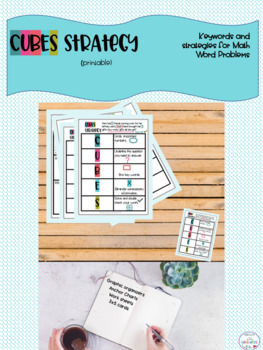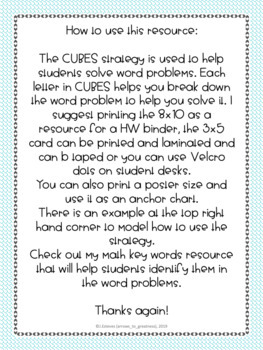CUBES Strategy for Math- how to solve word problems
arrows to greatness
324 Followers
Grade Levels
2nd - 4th, Homeschool
Subjects
Resource Type
Standards
CCSS3.OA.A.3
CCSS3.OA.D.8
CCSS3.OA.D.9
CCSS4.OA.B.4
CCSS4.OA.C.5
Formats Included
- PDF
arrows to greatness
324 Followers
Description
The CUBES strategy is used to help students solve word problems. Each letter in CUBES helps you break down the word problem to help you solve it. I suggest printing the 8x10 as a resource for a HW binder, the 3x5 card can be printed and laminated and can b taped or you can use Velcro dots on student desks.
You can also print a poster size and use it as an anchor chart.
This resource also includes some worksheets for students to practice and black and white versions of the graphic organizer and anchor charts.
There is an example at the top right hand corner to model how to use the strategy.
Check out my math key words resource that will help students identify them in the word problems.
Thanks again!
Total Pages
Answer Key
N/A
Teaching Duration
N/A
Report this resource to TPT
Reported resources will be reviewed by our team. Report this resource to let us know if this resource violates TPT’s content guidelines.
Standards
to see state-specific standards (only available in the US).
CCSS3.OA.A.3
Use multiplication and division within 100 to solve word problems in situations involving equal groups, arrays, and measurement quantities, e.g., by using drawings and equations with a symbol for the unknown number to represent the problem.
CCSS3.OA.D.8
Solve two-step word problems using the four operations. Represent these problems using equations with a letter standing for the unknown quantity. Assess the reasonableness of answers using mental computation and estimation strategies including rounding.
CCSS3.OA.D.9
Identify arithmetic patterns (including patterns in the addition table or multiplication table), and explain them using properties of operations. For example, observe that 4 times a number is always even, and explain why 4 times a number can be decomposed into two equal addends.
CCSS4.OA.B.4
Find all factor pairs for a whole number in the range 1-100. Recognize that a whole number is a multiple of each of its factors. Determine whether a given whole number in the range 1-100 is a multiple of a given one-digit number. Determine whether a given whole number in the range 1-100 is prime or composite.
CCSS4.OA.C.5
Generate a number or shape pattern that follows a given rule. Identify apparent features of the pattern that were not explicit in the rule itself. For example, given the rule “Add 3” and the starting number 1, generate terms in the resulting sequence and observe that the terms appear to alternate between odd and even numbers. Explain informally why the numbers will continue to alternate in this way.



